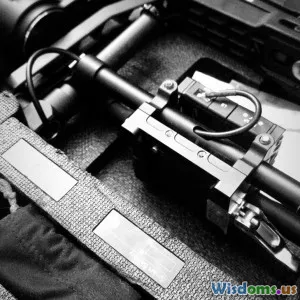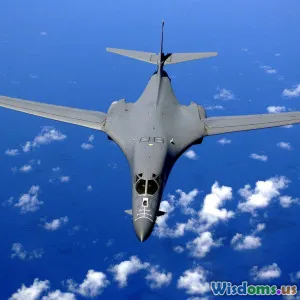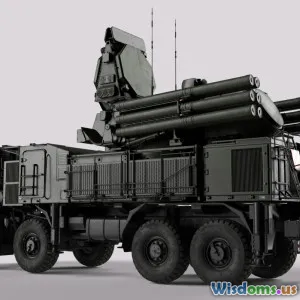
Future Trends Small Arms Innovations Coming by 2030
15 min read A forward-looking analysis of small arms innovations reshaping military, civilian, and law enforcement arsenals by 2030; from smart guns to green ballistics and beyond. (0 Reviews)
Future Trends: Small Arms Innovations Coming by 2030
Introduction: A New Chapter in Small Arms Evolution
By 2030, experts predict the world of small arms will look radically different from today’s arsenals. From futuristic military sidearms to next-generation sporting rifles, innovations are emerging that promise slimmer profiles, smarter capabilities, greater safety, and reduced collateral impact. But what does this technological revolution mean for security forces, civilian enthusiasts, and societies at large?
Globally, armed forces face shifting threats, urbanization, and the need to balance lethality with precision and accountability. Meanwhile, law enforcement and civilian markets drive demand for safer, more adaptable, and environmentally responsible firearms. Manufacturers—from traditional giants like Remington and Glock to disruptors like smart gun startups—are racing to deliver the next big breakthrough. As conflict environments change, technological progress accelerates, and regulatory frameworks tighten, the stage is set for a perfect storm of innovation.
What’s on the horizon? From biometric locks to AI-enhanced targeting and eco-friendly ammunition, here’s your in-depth guide to the small arms revolution ahead.
The Rise of Smart Small Arms: Biometric and Digital Evolution
Smarter, Safer Triggers
Small arms development is shedding its purely mechanical roots, embracing electronics and software to create “smart weapons.” These promise multiple benefits—especially in safety, accountability, and operational adaptability.
Biometric Safeguards
Smart guns equipped with biometric locks—fingerprint or palm recognition—ensure only authorized users can fire the weapon. This security upgrade drastically reduces the risk of accidents, theft, or weapons being used against their owners.
“Smart guns with integrated biometrics may become the new standard in police and civilian sidearms by the next decade,” predicts innovation analyst Rachel Porter in a 2023 Defense Technology Review.
Companies already piloting such technology include Germany’s Armatix (with RFID handguns) and the U.S.-based Biofire, which has garnered attention for its quick, reliable reader embedded in the firearm’s grip.
Digital Connectivity & Tracking
Beyond authentication, digitization brings connected capabilities to small arms. New “Networked Weapon Systems” enable:
- Live location tracking (benefiting military logistics and operators)
- Automatic shot logging (for accountability in policing and military operations)
- Remote disabling (to neutralize lost or stolen weapons)
For instance, the Defense Advanced Research Projects Agency (DARPA) is rumored to be developing “Internet of Things” (IoT) integration for field rifles, harnessing on-board sensors to assess usage, monitor environmental conditions, and relay maintenance needs.
Adaptive Fire Controls
Artificial Intelligence and advanced fire controls are finding their way into the firearm trigger group:
- Sophisticated digital safeties assess grip, movement, and context before enabling firing.
- “Smart” optics adjust zero and reticle data according to shooter profile or environmental input from weapon sensors.
The U.S. Army’s Next Generation Squad Weapon (NGSW) program is already testing AI-enhanced fire controls. According to the Army’s 2023 NGSW report, future infantry rifles may soon “automatically adjust aiming dot placement, windage, or even select ammunition modes for the user.”
Advanced Materials: Lightweight, Durable, and Modular
Polymer Powerhouses & Additive Manufacturing
Material science breakthroughs are allowing small arms to lighten up without sacrificing strength or longevity. Next-generation polymers, carbon fiber components, and hybrid metal alloys are becoming the new norm. Ruger, FN, and SIG Sauer have all announced lighter, more robust handguns and rifles incorporating these materials.
Meanwhile, 3D printing (also called additive manufacturing) is moving from niche to mainstream. The U.S. Army’s Armament Research, Development and Engineering Center (ARDEC) successfully field-tested 3D-printed M249 machine gun components in 2022. This technology promises:
- Rapid prototyping and field repair of broken parts
- User-customizable ergonomics (grips, stocks, rails)
- Cost and weight reduction compared to machined metals
Enhanced Durability & Coatings
Advanced ceramics, nano-coatings, and smart lubricants further reduce maintenance frequency and friction. Some new surface coatings can repel fouling and moisture, extending firearm lifespans even in harsh combat conditions.
James Cardwell, a materials engineer at SIG Sauer, claims that “ceramic-matrix composites and graphene-infused barrels may let some small arms survive 50% more rounds before crucial maintenance is needed.”
Modular Design: Configurability as Standard
Increased modularity is enabling the seamless swapping of barrels, stocks, optics, and control modules. Examples include:
- SIG SAUER’s MCX series, where barrels and calibers can be switched in seconds
- Beretta’s APX pistols, enabling grip- and slide-size changes to suit shooter preference
- Thales’ F90 modular assault rifle, designed for rapid adaptation from close-quarters battle to designated marksman roles
This versatility reduces supply chain strain and provides end-users with mission-specific flexibility never before possible.
Optics, Sights, and Target Acquisition: The Digital Revolution
Smart Sights & Digital Optics
Augmented reality (AR) and electro-optical sights are integrating rangefinders, ballistic calculators, and environmental sensors directly into weapon optics.
- TrackingPoint manufactures rifles with “precision-guided firearm” smart scopes that manage aiming, holdover, and trigger release for pinpoint accuracy.
- Steiner and Vortex are exploring AR overlays, projecting target data onto the ocular lens without dividing operator focus.
By the late 2020s, more optics will link directly to helmet-mounted HUDs (Heads-Up Displays) or export aiming data to squad-level tablets for coordinated targeting—effectively miniaturizing the battlefield’s sensor-to-shooter loop.
AI-Aided Target Identification
Machine vision and deep learning cameras are being built into optics to automatically distinguish combatants from civilians, thereby reducing blue-on-blue incidents and collateral damage in complex environments.
Notably, Israel’s Smart Shooter manufactures sight systems for small arms that automatically lock onto and track aerial or ground-based drones—demonstrating changing threat profiles for front-line soldiers.
Next-Gen Ammunition: Lethality Meets Responsibility
Novel Calibers and Reduced Signature
Traditional NATO calibers (5.56mm, 7.62mm) are evolving. Programs like the U.S. NGSW have adopted a new “6.8mm General Purpose” round, balancing extended range with manageable recoil.
Innovation priorities include:
- Subsonic projectiles that minimize sound and flash (ideal for urban ops and stealth)
- Cased-telescoped and polymer-cased rounds, cutting weight by up to 30%
- Hybrid metallic rounds for improved pressure management and ballistic efficiency
Environmentally Friendly Ammunition
By 2030, environmental mandates could see lead-based rounds all but eliminated—especially for training and law enforcement. Green alternatives include:
- Copper, tin, or steel slugs
- Biodegradable shot wads and casings, already in use for competition and hunting in many EU countries
- Nontoxic primers free of heavy metals
According to the EU’s ECHA (European Chemicals Agency), nearly three-quarters of European hunting cartridges sold in 2025 are forecasted to be lead-free, up from just 10% in 2018—a trend rapidly spreading worldwide.
Programmable and Enhanced Performance Rounds
The line between small arms and “smart munitions” is blurring rapidly:
- Programmable airburst ammunition, like that fielded on the U.S. XM25 grenade launcher
- Specialized ammunition for drone and anti-materiel use, optimized in energy and effects
These provide expanded capabilities, especially in urban combat and counter-UAS (unmanned aerial systems) operations.
Digital Arsenal: Integration with the Connected Soldier
The Weapon as a Network Node
Modern battlefield integration isn’t just for big-ticket hardware. Rifles, carbines, and handguns are joining the “Integrated Soldier System”—collaborating with drones, sensors, squad radios, and wider command-data networks.
- Bluetooth, Wi-Fi, and encrypted mesh network capabilities: Small arms can transmit ammunition counts, condition, or user info for logistical awareness.
- Predictive maintenance, using on-board diagnostics communicated to an armorer’s AI dashboard, as piloted in the British Army’s experimental weapon logbooks.
Training with Virtual and Augmented Reality
Small arms don’t stand alone. Immersive VR/AR-based training systems for new weapon recruits (civilian, police, or military) provide intense, data-driven feedback, simulate stressors, and support ongoing skill development.
Companies like MILO Range, and VirTra are leading this revolution—ensuring that operators are as adaptive as their high-tech weapons.
Answers to Changing Threat Environments
Urban Operations Take the Lead
With the majority of the global population now living in cities, conflict and public safety demands have shifted. Small arms in 2030 will increasingly prioritize:
- Compact platforms for maneuverability in tight spaces
- Low-collateral, precision rounds to reduce civilian harm
- Enhanced suppression and stealth capabilities
Counter-drone and counter-explosive roles (even for pistols and carbines) require new sighting systems and flexible magazine/ammunition loadouts.
Civilian and Law Enforcement Impacts
Innovations will not be confined to military uses. Expect growing pressure—politically and commercially—for adoption of smart safeties, track-and-trace features, and environmentally conscious munitions in the civilian and law enforcement markets.
U.S. police departments are already trialing smart guns to reduce liability. Sporting shooters and hunters benefit from lighter, durable arms and reduced-toxicity rounds. Urban self-defense weapon sales will likely see an uptick for smart pistols and digitally secured pistols.
Challenges and Ethical Questions
Privacy, Hacking, and Systemic Risks
As digital features proliferate, so do cybersecurity concerns. Could a weapon be disabled or tracked by a malicious third party? Manufacturers and end users must prioritize robust, encrypted systems and regular software updates.
Cost and Adoption Rate
Historically, high-tech small arms have faced slow civilian and developing-country adoption due to cost. Mass acceptance, therefore, may rely on government incentives or industry partnerships to ensure the latest advancements don’t stay out of reach for intended end users.
Ethics and Legal Hurdles
Autonomous targeting features and AI-aided identification spawn critical questions:
- Who is responsible for attribution of automated fires?
- How will collateral impact be addressed and regulated?
- Does remote disablement conflict with private property or defense rights?
Agencies such as the United Nations and European Union are already examining international arms law updates in anticipation.
Conclusion: Towards a Safer, Smarter, and More Sustainable Arsenal
By 2030, small arms will be lighter, stronger, greener, and smarter—ready for everything from peacekeeping and urban counter-terror to wilderness hunting and ethical sport shooting. Emerging from this perfect storm of technological innovation, we may see unprecedented leaps in safety, precision, and operational adaptability—blurring lines between software and steel, soldier and sensor.
For militaries and law enforcement, these advances could reset the calculus of deterrence, response, and control, favoring those who adapt fastest. Civilian markets will see exciting but contentious debates about personal rights, privacy, and accountability. Amid it all, responsible innovation—anchored by robust governance—will be the key to unlocking a future where small arms play a legitimate, controlled, and ever-safer role.
The coming decade is poised to witness not just an upgrade of hardware, but a redefinition of what a small arm is, does, and promises. The arms race of the 21st century, it appears, will be led as much by lines of code as by lines drawn on blueprints.
References
- U.S. Army Next Generation Squad Weapon (NGSW) Program Reports, 2022-2023
- European Chemicals Agency (ECHA) on lead-free ammunition trends
- Defense Advanced Research Projects Agency (DARPA) press releases, 2023
- Rachel Porter, "The Dawn of Biometric Firearms," Defense Technology Review, 2023
- SIG Sauer corporate communications, 2023
- “The Impact of AI in Modern Warfare,” International Institute for Strategic Studies (IISS), 2023
Rate the Post
User Reviews
Popular Posts

















